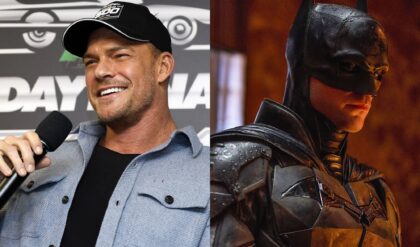In the salt-crusted haze of North Carolina’s coastal marshes, where the Atlantic laps at the edges of decaying docks like a predator testing for weakness, a family clings to power with bloodied hands and buried secrets. The Buckley clan isn’t just fighting the tides—they’re swimming with sharks, smuggling peril through the very waters that built their empire. Welcome to The Waterfront, Kevin Williamson’s pulse-pounding 2025 Netflix thriller that dropped all eight episodes on June 19 and immediately hijacked sleep cycles worldwide. Inspired by the gritty true tales of coastal smuggling rings that Williamson’s own fisherman father navigated in the 1980s, this series isn’t your glossy Succession boardroom brawl; it’s a raw, rain-soaked gut-punch of familial fracture and moral freefall. Starring Holt McCallany as the iron-fisted patriarch Harlan Buckley and Maria Bello as his steely matriarch Belle, The Waterfront blends Ozark‘s criminal ingenuity with Bloodline‘s sibling savagery, all set against the brooding beauty of Wilmington’s working-class ports. Critics called it “boilerplate with bite,” but fans? They’re torching Twitter (or X, whatever) with pleas for resurrection after Netflix axed it after one season in August. If you haven’t surrendered to its siren call yet, clear your queue—because once the credits roll on that finale cliffhanger, you’ll be pacing your living room at dawn, screaming for more.
To hook you before the first wave crashes, let’s map the treacherous waters of the Buckleys’ world. Havenport, the fictional stand-in for real-life smuggling hotbeds like Wilmington and Southport, is a character as unforgiving as the family at its core. Fog-shrouded inlets hide midnight handoffs, shrimp boats double as ghost ships for cartel cargo, and the local eatery—Buckley’s Dockside, a neon-lit beacon of fried oysters and false smiles—serves as ground zero for deals that could drown them all. The series opens with Harlan, fresh off two heart attacks that sidelined him for years, storming back to reclaim his throne. His wife Belle, the pragmatic queen bee who’s kept the fishing fleet afloat through sheer cunning, has been calling the shots, but her “side hustles” have drawn the wrong kind of heat. Enter the kids: Cane (Jake Weary), the hot-headed heir apparent with a hair-trigger temper and a gambling debt that could sink the armada; Bree (Melissa Benoist), the prodigal daughter clawing her way out of rehab, her sobriety as fragile as the glass she shatters in fits of rage; and Peyton (Danielle Campbell), the wide-eyed youngest, caught in the crossfire of her siblings’ sins. Lurking in the shadows is Shawn West (Rafael L. Silva), the charming new bartender whose easy grin hides a bombshell: he’s Harlan’s illegitimate son from a long-ago fling with a former waitress. And then there’s Grady (Topher Grace), the smarmy corporate shark circling with buyout offers laced with blackmail, his sociopathic charm turning every negotiation into a knife fight.
Williamson, the Scream mastermind who turned teen slasher tropes into cultural catnip and Dawson’s Creek into a blueprint for angsty romance, dips into his personal well for The Waterfront. “My dad was a fisherman who turned to smuggling when the quotas dried up,” he shared in a pre-premiere chat, infusing the script with authentic salt: the creak of barnacle-crusted hulls, the metallic tang of blood on a filleting knife, the way a Carolina drawl can sweeten a threat. Directed in its pilot and sophomore episodes by Marcos Siega (You, Dexter: New Blood), the show wastes no time plunging viewers into the deep end. Episode 1, “Almost Okay,” kicks off with a botched handoff: a cartel speedboat collides with a Buckley trawler, spilling bodies and blow into the surf. Cue the cover-up—a frantic dawn scramble where Harlan barks orders like a drill sergeant, Belle torches evidence in a backyard bonfire, and Cane’s impulsiveness nearly outs them to a nosy Coast Guard cutter. From there, it’s a relentless current of escalating stakes: a DEA mole (Dave Annable in a recurring arc) sniffing around the docks, rival smugglers dumping rivals in gator-infested swamps, and a suspicious shipwreck that pulls federal eyes straight to Havenport.
What makes The Waterfront a sleep thief isn’t just the plot’s hairpin turns—though there are plenty, from a mid-season betrayal that redefines “family first” to a finale gut-punch involving a long-lost ledger of dirty deals—it’s the suffocating intimacy of the Buckleys’ dysfunction. These aren’t cartoon crooks; they’re your neighbors, weathered by economic erosion and ethical erosion in equal measure. Harlan, played by McCallany with the brooding intensity that made him a Mindhunter icon, is a titan of contradictions: a doting grandpa who reads bedtime stories from dog-eared Hemingway, yet the same man who once fed a snitch to the sharks. His return isn’t triumphant; it’s terrifying, a grizzled lion reclaiming his pride by any means, heart meds rattling in his pocket like a death knell. Bello’s Belle is his perfect foil—a mama bear with brass knuckles, her Southern belle facade cracking to reveal a woman who’s traded lullabies for ledgers. “I’ve buried more than my regrets in these marshes,” she drawls in one standout scene, torching a rival’s boat while humming an old gospel tune. Benoist’s Bree steals hearts and episodes, her arc from fragile flower to feral force a masterclass in redemption’s razor edge—think Supergirl grit meets Euphoria‘s vulnerability. Weary’s Cane is the powder keg, his volatile charm masking daddy issues that explode in bar brawls and back-alley executions, while Campbell’s Peyton provides the wide-eyed innocence that keeps viewers rooting for this trainwreck tribe.
The ensemble’s alchemy turns soapy suds into something sharper. Grace’s Grady is a delicious deviant, slithering through boardrooms with That ’70s Show smarm upgraded to serial-killer sleek—his torture scene via remote-controlled drone is equal parts hilarious and horrifying. Silva’s Shawn adds layers of quiet menace, his reveal as the bastard Buckley brother dropping like a depth charge, forcing Harlan to confront the ghosts he’s netted over decades. Supporting players like Humberly Gonzalez as a sharp-tongued dockside enforcer and Brady Hepner as a teen sidekick entangled in the web round out a cast that’s less “star vehicle” and more pressure-cooker ensemble, every glance loaded with unspoken alliances and animosities.
Visually, The Waterfront is a love letter to the Lowcountry’s lethal allure. Cinematographer Dana Hawley (The Whale, Maestro) drenches Wilmington’s waterways in moody blues and bruised purples, drone shots sweeping over fog-choked fleets like omens from a Brontë novel. Siega’s helming infuses the action with kinetic chaos—hand-to-hand dock fights that feel like wet-fish wrestling matches, speedboat chases slicing through bioluminescent wakes. John Frizzell’s score, released day-and-date by Lakeshore Records, throbs with a hybrid of bluegrass banjo and trap beats, the twang underscoring tense family dinners where silverware clinks like cocked hammers. Production wrapped in December 2024 after a grueling shoot amid real hurricanes, lending authenticity to the storm sequences that batter both boats and bonds.
From the jump, The Waterfront was a binge beast. Episode drops aligned with summer solstice vibes, and viewers dove in headfirst: it clawed to No. 1 in Netflix’s global Top 10 English series for three straight weeks, amassing 11.6 million views in its debut frame alone—outpacing even buzzy renewals like Ransom Canyon. Social media erupted like a powder keg: TikTok edits of Cane’s rage-fueled monologues racked up millions, while Reddit’s r/television lit up with threads like “Binged till 4 AM—Harlan’s my problematic fave” and “This family’s messier than my ex’s DMs.” X (formerly Twitter) became a war zone of midnight confessions: “Just finished Ep 6 at 3:47 AM. Sleep? What’s that? #TheWaterfront” trended alongside fan art of the Buckleys as twisted royals. One viral post summed it: “Netflix, if you cancel this after that cliffhanger, we’re rioting like the cartels.” Critics were a mixed bag—Rotten Tomatoes at 68% approval, with Variety hailing its “soapy melodrama in the best ways” but The Hollywood Reporter griping over “artificial settings and thin characters.” Metacritic echoed the divide: “Mercilessly entertaining” from some, “hack plot wasting great cast” from others. Yet audiences scored it higher, a 7.0 on IMDb, with raves for the “visceral family foundation” and pleas that it “feels like Dallas on steroids.”
The backlash hit tidal-wave force in August when Netflix pulled the plug after one season, citing “strategic shifts” despite the metrics screaming renewal. The Waterfront lingered in the Top 10 for five weeks, besting several greenlit shows, but as a Universal Television import, it apparently swam against a higher renewal current. Fans didn’t drown quietly: petitions surged on Change.org (“#SaveTheWaterfront—Give the Buckleys Their Due!”), amassing 50,000 signatures by September. X campaigns trended globally—”Why Ransom Canyon S2 but Waterfront axed? Make it make sense!”—with cast members like Benoist retweeting pleas: “The outpouring means everything. Harlan’s story isn’t over.” Williamson, ever the storyteller, teased in a podcast drop: “The finale was designed as a launchpad—loose ends begging for knots.” Even in November 2025, four months post-cancellation, the clamor persists: recent X posts lament “binging it again at 2 AM, still mad no S2,” and fanfic floods AO3 with alternate seasons where Bree topples Grady in a blaze of glory. It’s a testament to the show’s sticky hooks—those unresolved threads, like Shawn’s simmering revenge and the cartel’s encroaching tide, leave viewers adrift in “what if” purgatory.
Yet amid the fury, The Waterfront shines as a snapshot of Williamson’s evolution: from ’90s teen heartthrobs to adult abyss, trading ghostface masks for gutted fish. It’s not flawless—the early episodes drag in exposition, and some twists veer into telenovela territory—but its heart beats true in the Buckleys’ brutal ballet. In an era of algorithm-fueled fluff, this thriller dares to dredge up the American underbelly: how blue-collar legacies curdle into crime when the nets come up empty, how love twists into loyalty’s noose. Holt McCallany nailed it in a Tudum interview: “Harlan’s no hero—he’s just a man who’d burn the world to keep his afloat.” As November chill sets in, with holiday binges looming, The Waterfront remains the perfect storm-watch: addictive, infuriating, unforgettable.
So, heed the warning—this isn’t passive viewing; it’s possession. Fire up Netflix, dim the lights, and let the Buckleys drag you under. By episode’s end, you’ll be bleary-eyed, buzzing, and joining the chorus: Netflix, reverse course. The fans demand Season 2, and damn if they don’t deserve it. Harlan’s still got sharks to feed.





